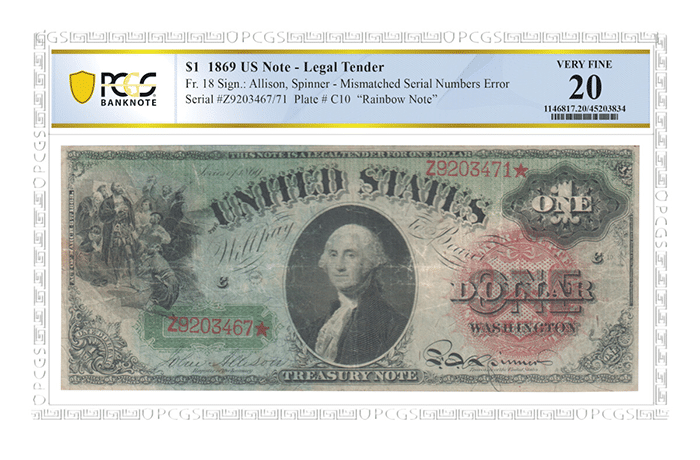
By Philip Thomas for PCGS ……
Unlike coins, the large majority of banknotes do not enjoy the anonymity that comes with not having a distinctive number indelibly marked on its surface – in most cases twice or more. These identity-defining serial numbers leave little room for confusion or misunderstanding. The hard-and-fast rule is one number per banknote and one banknote per number. Classification and organization are literally as simple as “one, two, three”.
…Unless, of course, a banknote happens to have two different serial numbers, as is the case with this extremely uncommon 1869 $1 Legal Tender “Rainbow” error note, recently authenticated and graded by PCGS as Very Fine (VF) 20. All the rules get thrown out the window when this note enters the room.
Look closely. At the lower left, you will see Z9203467 overprinted in red ink, and at upper right, Z9203471. A profound two-digit differential – the last two digits representing a four-number discrepancy in the sequence! Just in case anyone is wondering, the large red stars at the end do not indicate that this is a “Star Note”. Before 1910, stars were simply used as place-holding “bookends” to the numbers on certain issues and did not signify a replacement.
Let’s begin the analytical dive into this curious piece by asking the question: Why do most U.S. banknote issues have more than one serial number printed on them in the first place? The answer is fairly simple.
Since paper is a rather delicate medium, susceptible to damage while in circulation, printing the serial number twice at opposite corners of the banknote allows for some portion of the note to become stained, scuffed, or severed off altogether while still retaining at least one of its important numeric identifiers (side note: under federal law, a United States banknote is still redeemable at full value as long as more than half of the note is clearly present).
The next question is: How could this have happened?
In general terms, either operator (i.e., human) or mechanical error is to blame. More specifically, the two independently acting numbering blocks responsible for overprinting the serials are inadvertently set to different numbers prior to the commencement of the production run (operator error), or one of those blocks jams or clogs, failing to advance, while its counterpart continues to function as intended (mechanical error).
This type of error on a large format (pre-1928) issue is particularly rare. Only an amount slightly better than a dozen are known from all types and varieties of large notes and more than half of those notes involve serial numbers that differ by just a single digit. Remember, this is a two-digit disparity.
Further augmenting the “coolness factor” here is the fact that this error occurred on one of the most lauded and visually stunning designs of U.S. banknotes out there. Nicknamed the “Rainbow” series, the 1869 Legal Tender issues display a multitude of colors, including blue-tinted paper at center left, green-tinted underprints, red serial numbers, and a giant, pinkish-red Treasury seal.
I suppose this could be called “The Mismatched Rainbow”!
* * *





